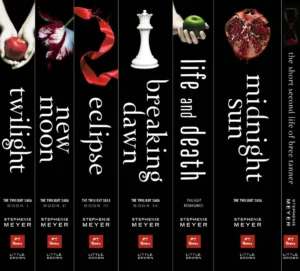
One Saturday evening last month, I piled into a packed theater and chanted “Bella! Where the hell have you been, loca?” with a group of strangers. We cheered at the sight of Billy Burke on the screen and laughed at the absurdity of the world’s greatest teenage romance. Of course, I was nowhere other than at a screening of The Twilight Saga: New Moon.
New Moon ranks among the saddest of the five-film cohort that makes up the franchise. Its standout moments include “Bella’s Depression Sequence” and “Bella Jumps off a Cliff.” Still, attendees of the screening, me included, were in high spirits. Even singing along to the iconic song “Possibility” by Lykke Li playing over Bella’s spiral.
At the time of New Moon‘s release in 2009, admitting you enjoyed The Twilight Saga was akin to—I don’t know—burning the Bible. The only thing more popular than Twilight was the countless parodies of the franchise. However, in recent years, the tone around the series has shifted. The theaters are full, the formerly mocked are doing the mocking, and the original fans are looking around like “Where the hell have you all been, loca?”
The first hint of the Twilight Renaissance was in 2018 with fans revisiting the franchise to commemorate the 10th anniversary of the first film’s release. In 2020, nostalgia-fueled fan interactions with the franchise picked up as the world outside shifted into something unrecognizable. Now, the hashtag #Twilight on TikTok has 1.5 million posts with more than 32 billion overall views.

Social media was in its most precursory stage when Stephanie Meyer published Twilight, the book, in 2005. Though there was not a corner of pop culture left untouched by the saga, the ways fans found community or connected with the work were nowhere near the level of accessibility they are today. Along with the renaissance came entire meme pages, new ways of making and selling merch, easy-access forums to discuss the series, in-depth analysis of the franchise, and so much more.
The social progress of the last two decades has a hand in the renaissance as well. Now fans have more vocabulary and awareness to discuss the more problematic themes of the series. Whether it’s the way Indigenous Americans were portrayed in the books and films or discussing Edward’s “red flags,” even our most basic understanding of the text has shifted to a new landscape.
Aside from the school libraries that attempted to ban it, much of the early criticism of the series had less to do with its content and more with who seemed to be enjoying it. To put it plainly, many people decided Twilight was bad solely because it was something women and girls liked. It is no surprise that a story in which two teenagers—well, a teenager and a 109-year-old—unabashedly reject the laws of man in the name of love was seen as something less than sophisticated.
In 2008, it could feel like peak feminism was a man saying he liked the color pink and the idea that women and girls simply could not be intellectual in the same way as men and boys was everywhere. Like anything that was seen as “girly” automatically qualified as “bad.” Some women who wanted to differentiate themselves as a way to gain male approval jumped on the hate bandwagon to prove that they “weren’t like other girls.” What I am saying is Twilight was an easy target.
But lucky for us old-school Twihards, the culture has propelled forward, lapsed tremendously, and circled back just enough to land us in a sweet spot of unapologetically taking back what’s ours. Now, we don’t dismiss things because women and girls like them. I mean, remember when women’s interests saved the global economy last year? And honestly, with all the other stuff going against us, like a theoretical federal abortion ban and the rise in antifeminist belief, who has time to worry about people judging the things you like?
The thing about The Twilight Saga is that it is so deeply terrible, problematic, and weird. It seems to be all of the things people who were “too cool” for it were labeling it as—that is precisely what makes the Twilight Renaissance so fun. There is a comfort in revisiting something and knowing exactly what will be there. Looking back on something you loved with a new perspective unlocks a new kind of relationship with the work. One that can be much more expansive and thought-provoking. One that allows for the younger version of oneself to come to the surface and have their interests validated, even celebrated. Everyone deserves their time to sparkle in the sun.
